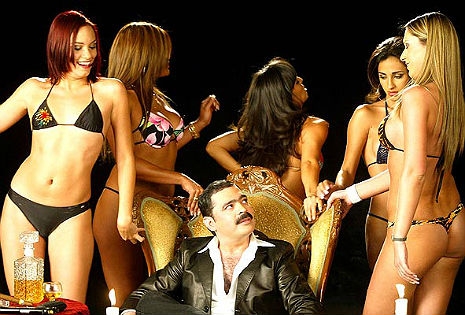
It’s normal for people to fantasize about having their own theme song. But thanks to the outlawed narcocorrido genre of Latin music, if you are a major drug smuggler or head of a Mexican drug cartel, you really do have your very own customized theme song.
It’s not enough to move millions of dollars worth of illegal drugs, intimidate rivals, scare journalists, accumulate a ton of flauntable personal wealth, and control large swaths of Mexico. One has to also be a modern-day folk hero and have ballads (corridos = traditional Mexican ballads) written about one’s criminal exploits.
Corridos originally used the medieval European ballad form to chronicle stories about heroes, revolutionaries, soldiers in the Mexican War, and outlaws like Pancho Villa or Emiliano Zapata. Drug smugglers view themselves as part of this lineage. The long-standing tradition of the corrido is anti-authoritarianism, with or without a drug culture to go along with it.
Cartel leaders pay Mexican songwriters to write glowing tributes to them, their organization, and superior products. It’s a great gig if you can get it… and don’t mind pissing off the leaders of other cartels, who might well kill you and your family for promoting the wrong side. Vice reported: “Sometimes narcocorrido singers avoid getting offed by getting songs approved by various cartels. Movimiento Alterado [another name for the narcocorrido genre] has sent songs to the Sinaloa cartel for clearance before releasing them.”
A norteño singer-songwriter from Monterrey named Edgar told me about the dilemma facing young artists. He left Nuevo Leon to start a Regional Mexican band in the U.S., where some of his relatives had already immigrated, because he didn’t want to write about the drug culture and no longer felt safe being a songwriter in Mexico.
Narcocorridos are banned from the radio and public performance in the states of Sinaloa and Chihuahua. This level of censorship is ludicrous considering the number of Spanish language radio stations in the U.S. with signals reaching far into Mexico, not to mention satellite radio and the internet.
Officials recently fined concert promoters in Chihuahua $8000 for allowing El Komander (Alfredo Rios) – whose catalogue was described by Latin Times as “one full of tall tales of pistol-packing drug traffickers and cartel dons” – to perform his work.
The fine was so high because Los Tucanes de Tijuana – whose shows have turned into shootouts in the recent past – were hired to appear at a music festival in Chihuahua City this summer and blithely paid the 23,000 pesos (about $1700) fine so they could play. Then the city raised the fine to 100,000 pesos ($7500). The mayor, Marco Quezada, said that he won’t issue another concert permit to the promoter who brought the narco-balladeers to town.

The template for the criminal folk hero is Robin Hood-like “generous bandit” Jesús Malverde, the patron saint of the illegal drug trade (along with Santa Muerte), especially in Sinaloa. Unofficial saint, because Malverde is just one example of local Mexican Catholic folk customs enraging and embarrassing the Vatican. He is said to have only stolen from the rich and helped the poor until he was killed by police in 1909.
The regular level of violence in this musical subculture far exceeds rap’s bad reputation. Singer Valentín Elizdale was murdered in front of hundreds of people in 2006 after a concert during which he sang lyrics insulted the Zetas cartel. Sinaloa’s beloved Chalino Sánchez, who performed mainly in southern California, was one of the major musical casualties of the drug war. He began writing narcocorridos to order at the request of his fellow inmates while in jail, and despite his weak voice, the song commissions kept coming once he was released. In 1992 when an audience member shot him during a concert, Chalino pulled out a gun and shot back. Unfortunately someone finally succeeded in murdering Chalino execution-style a few months later.
Narcocorridos, for all their dark, boastful, nihilistic, violent lyrics, sound…well, like cheerful polkas and waltzes. Trust me, I lived next door to people who played this music at top volume 24/7 for three years straight. A quick browse of the CD’s at a bodega or mercado reveals that most of the artists look like clean-cut pick-up truck driving cowboys, wearing tight jeans with huge belt buckles and cowboy hats. They do not resemble East L.A. cholos or Latin rappers in any way. If the Marlboro Man had a tidier Latino counterpart who was holding an assault rifle while surrounded by scantily clad women, he would be a narcocorridos singer.
Juan Carlos Ramirez-Pimienta, a teacher and scholar at San Diego State University, told Vice:
The narcocorridos react to reality. The cartels are at war, so the narcocorridos adopt a wartime propaganda message. They are meant to create fear in the enemy.
Composer Enrique Franco Aguilar disapproves of the drug culture and its glorification but loves corridos. Franco told music journalist Elijah Wald:
Too many of these “artists,” in quotation marks, only want money. But when you have a good interpreter the corridos can still have a very strong effect. Because the people believe in these artists. If the artists wanted, they could make a revolution. A great artist is more powerful than a politician.
The muy macho El Komander, waving lots of guns around after possibly raiding Johnny Cash’s closet, in “Mafia Nueva,” below
Previously on Dangerous Minds:
Valentin Elizalde: Raw Live Narcocorridos
‘El Narco’: An Epic and Bloody Mexican Gangster Film





